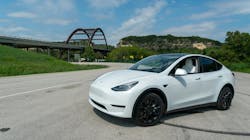The Rise of RISC-V and ISO 26262 Compliance
What you’ll learn:
- The pivotal role of RISC-V technology in revolutionizing automotive electronics.
- RISC-V advantages for silicon vendors, Tier-1 suppliers, and OEMs.
- How ISO 26262 compliance ensures functional-safety standards.
RISC-V technology is beginning its inroads into automotive electrical/electronic (EE) architecture design. Four major trends are driving this evolution: the surge in electric vehicles (EVs), advances in self-driving technology, the emergence of software-defined vehicles (SDVs), and vehicle-to-everything (V2X) connectivity.
The extensible RISC-V instruction set architecture (ISA) offers major advantages for automotive silicon vendors, Tier-1 suppliers, and OEMs. High-performance efficiency, a modular ISA, and emphasis on security make RISC-V an attractive choice for automotive applications. Moreover, RISC-V's open ecosystem fosters innovation and collaboration, driving its widespread adoption across the automotive industry.
As industry leaders like Andes Technology pave the way with ISO 26262 international functional-safety-standard certified RISC-V CPUs, the automotive sector is poised for a new era of innovation and reliability.
Current Electric- and Autonomous-Vehicle Trends
Rapid adoption of electric vehicles is evident with the Tesla Model 3 announced in 2019. According to Automotive News Europe, the Model Y emerged as the best-selling car in Europe in 2023 (see figure). Thus, the reality of EVs becomes ever-clearer, as they’re on the way to replacing traditional fossil-fuel cars in the future.
The adoption of self-driving vehicles advanced in 2022, when the German government certified Mercedes for level 3 (L3) autonomous driving (AD), the third of six AD levels. At L3, the vehicle can manage most aspects of driving under specific conditions or environments. The system can make decisions and respond to the driving environment, but the driver must be prepared to take over when prompted by the system.
The computer is increasingly taking over the driving function with the human driver assisting. Eventually, at L4 and L5, the time spent driving can be more productive: It will allow drivers to make conference calls, answer e-mail and text messages, or simply admire the view outside the window.
Software-Defined Vehicles and V2X
The progress toward the SDV is beginning to show progress. According to a Wards Intelligence 2023 SDV survey, by 2028 or 2029, half of all new vehicles may have software-defined architectures. As vehicles become connected and updatable, carmakers can add new features such as those for the infotainment system and vehicle control—advanced driver-assistance systems (ADAS), digital cockpit, and diagnostics.
The move toward SDVs is another step toward V2X connectivity. Information between the car and its surroundings will eventually become constantly bidirectional. The car will no longer be an island unto itself, but rather become part of the smart city. Connecting the car with the city network can achieve a better transportation experience. A report from the 5G Automotive Association concludes that by 2029, there will be mass deployment of dynamic intersections and cooperative traffic flows.
These trends demand a new automotive EE architecture. One of the first changes resulting from this new architecture is to reduce complexity in the modern automotive system. Today, the system restricts development speed, is too complex, and lacks the flexibility and extensibility to add new features. For example, the wiring harness has become the second heaviest part of the car and is the third highest cost component.
Another example is the electronic control unit (ECU) engineered with tightly coupled software and hardware. In the past, the ECU was designed for a dedicated purpose, thus making it hard to implement complex functions across multiple ECUs. In addition, it makes over-the-air software upgrade very difficult if not impossible. On top of that, the increasing intelligence in a car combined with many more sensors requires increased network bandwidth and computer power.
The evolving EE architecture will address these issues. It will be a scalable and centralized architecture for software development to enable an SDV with an over-the-air upgrade. It will also simplify wiring and connectivity to reduce costs and ease hardware upgrades.
The traditional automotive architecture is distributed with many ECUs designed for dedicated purpose. The new EE architecture will create separate domains for ADAS, vehicle infotainment, powertrain, etc. Each domain will contain powerful CPUs to deal with the many features in the domain. This will eventually lead to a zonal architecture, where a few supercomputers will direct many tasks and diverse functionalities.
The Role of RISC-V in Automotive Industry Innovation
What are the advantages of RISC-V in the automobile industry for silicon vendors, Tier-1 suppliers, and OEMs? For one, RISC-V offers high-performance efficiency. Another is that it enables a state-of-the-art, clean-slate design with low latency and a modular ISA. Such flexibility allows for compact states in the CPU ISA, fostering innovation in domain-specific functionality. Customization options abound, enabling extensible and flexible design.
RISC-V delivers outstanding price, performance, area (PPA) and its architecture scales seamlessly from MCU to data-center applications. In addition, RISC-V offers a flexible business model. And the RISC-V ISA prioritizes security, encompassing features like memory protection, hardware-enforced isolation like trusted execution environment (TEE), virtualization, and even crypto instructions.
For OEMs and Tier-1s, RISC-V provides multi-sourcing and supply-chain security, presenting a second CPU ISA option. RISC-V is an open ISA, meaning it offers a rich ecosystem with abundant independent resources for leverage. This facilitates vertical integration within the value chain, enabling differentiation and creation of competitive solutions through the expansion of RISC-V offerings. Moreover, the RISC-V ISA complies with functional-safety and security standards.
RISC-V Ramps Up Across the Industry
RISC-V has already demonstrated its efficacy and widespread adoption, extending from edge to data-center applications and increasingly penetrating automotive electronics. According to The SHD Group RISC-V Market Report, RISC-V is expected to experience a 146.2% CAGR from 2018 to 2025.
The momentum behind RISC-V growth is being driven by industry leaders such as Bosch, Infineon, Nordic Semiconductor, NXP, and Qualcomm, which are spearheading the semiconductor industry's adoption of RISC-V. Renesas has also embraced RISC-V in the automotive market. Additionally, companies like EPI, Mobileye, and others have integrated RISC-V into their computing processors.
Rambus turned to RISC-V for its root-of-trust security solution. Kneron implemented RISC-V for its automotive AI solution, while ILITEK adopted Andes’ functional-safety RISC-V for its Touch and Display Driver Integration (TDDI) solutions.
Numerous individual software vendors, including Green Hills and IAR, offer RISC-V functional-safety compilers. Imperas provides virtual-platform acceleration models, overseeing secure monitoring for the physical and execution environments. Furthermore, tools from companies such as LDRA, Parasoft, and Solid Sands offer solutions to verify functional-safety software for RISC-V.
Read more articles in the TechXchange: RISC-V: The Instruction-Set Alternative.
About the Author
Simon Wang
Senior Technical Marketing Manager, Andes Technology
Simon Wang is the Senior Technical Manager at Andes Technology. Prior to Andes, he worked as software architecture engineer at MediaTek and MOXA. He obtained a master's degree in electrical and control engineering from National Yang Ming Chiao Tung University.


